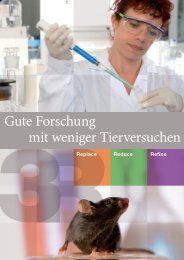Create successful ePaper yourself
Turn your PDF publications into a flip-book with our unique Google optimized e-Paper software.
cells in cultures in vitro stimulated with<br />
T- and B-cell mitogens. On the other<br />
hand, several examples of stimulatory<br />
responses in cultures treated with<br />
TiO2, PLGA-PEO and magnetite have<br />
been observed. Our results indicate<br />
that the most resistant immune<br />
response against reference NPs is<br />
phagocytic activity of granulocytes.<br />
No significant differences were found<br />
also in natural killer cell activity<br />
of cells treated with non-cytotoxic<br />
concentrations of NPs.<br />
proven quite tolerant of nanomaterial<br />
interferences. Issues regarding<br />
reliable dispensing of nanomaterial<br />
dispersions have been encountered<br />
for some materials but measures are<br />
been talking to eliminate this source<br />
of variability.<br />
Progress made over the last year: Five<br />
assays have been so far selected to be<br />
used for HTS and HCA compared with<br />
one last year. SOPs have been developed.<br />
Progress made over the last year: Immunotoxicity<br />
is completed for most of<br />
assays, for most promising methods<br />
SOP has been developed (none reported<br />
last year).<br />
In Vitro Screening Tests:<br />
Assay Automation<br />
• High-throughput screening (HTS)<br />
and high-content analysis (HCA)<br />
techniques have been applied to<br />
develop a set of reliable in vitro<br />
nanotoxicity assays that can be used<br />
for testing large sets of nanomaterials.<br />
Candidate assays were selected based<br />
on their suitability for automation and<br />
the relevance of the toxicological<br />
information they provide. Priority was<br />
given to endpoints/assays related<br />
to oxidative stress and genotoxicity.<br />
Manual protocols were translated<br />
into automated workflows without<br />
compromising any critical steps. The<br />
imaging-based HCA assays allow the<br />
detection of several biological effects<br />
within the same experiment, and have<br />
In Vivo & Ex Vivo Studies<br />
• In vivo toxicity studies have been<br />
performed to validate in vitro<br />
findings. Female rats were exposed<br />
to 3 doses of oleic acid coated<br />
irone oxide NPs, 0.1%, 1% and 10<br />
% of LD50 (detemined in acute<br />
toxicity study according to OECD<br />
TG425) by intravenous injection.<br />
A range of biomarkers have been<br />
followed in parallel to in vitro studies<br />
to be able to compare in vivo with<br />
in vitro. Markers of cardiotoxicity<br />
(mitochondrial coenzyme Q, oxidative<br />
phosphorylation), hepatotoxicity,<br />
damage in lung tissue cells, renal<br />
toxicity, genotoxicity (micronucleus<br />
test in bone marrow, strand breaks<br />
and oxidised DNA damage in white<br />
blood cells and lung tissue cells by the<br />
Comet assay), oxidative stress (in liver,<br />
lung, brain, heart tissues and in blood),<br />
immunotoxicity (immune function<br />
assays: proliferation activity of<br />
lymphocytes, phagocytic activity and<br />
respiratory burst; immunophenotypic<br />
PROGRESS REPORTS FROM EU-FUNDED PROJECTS<br />
Progress Report 2011 & AXLR8-2 Workshop Report<br />
125




